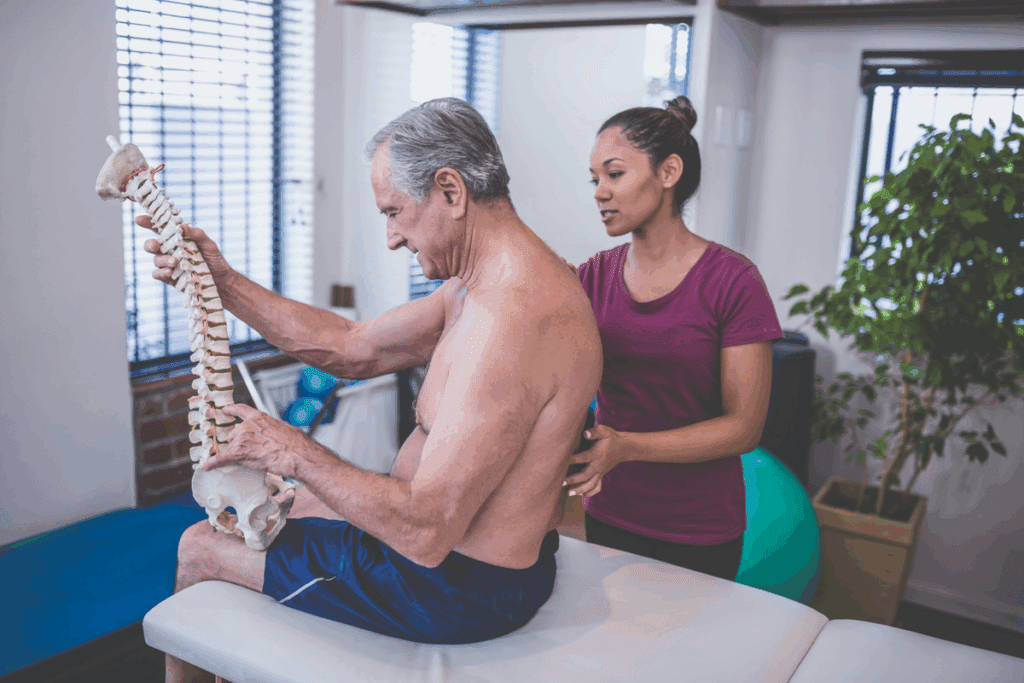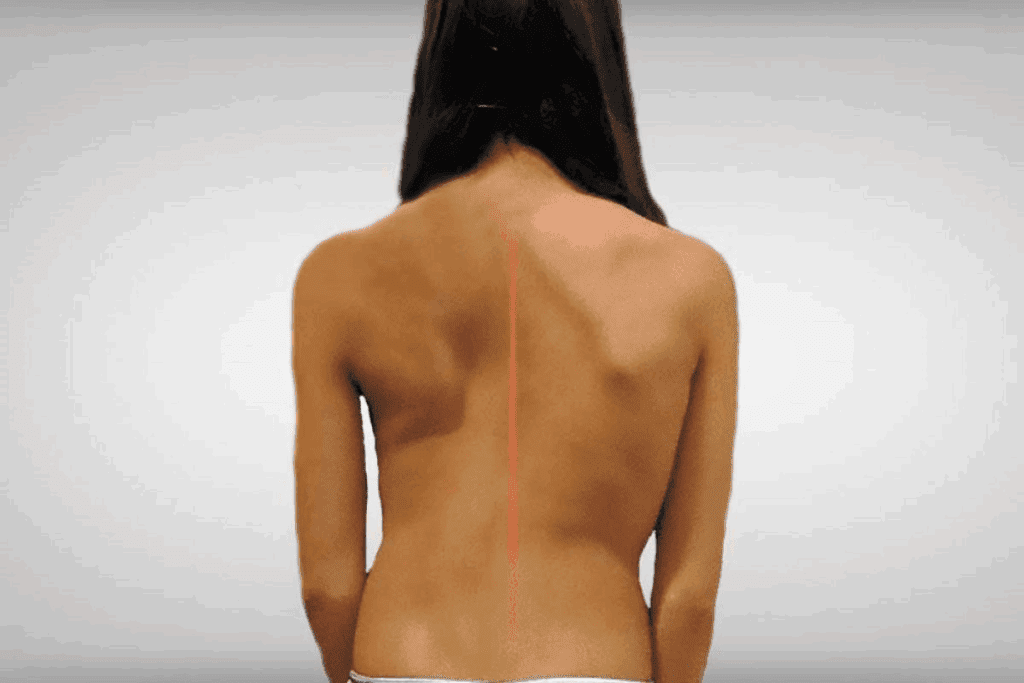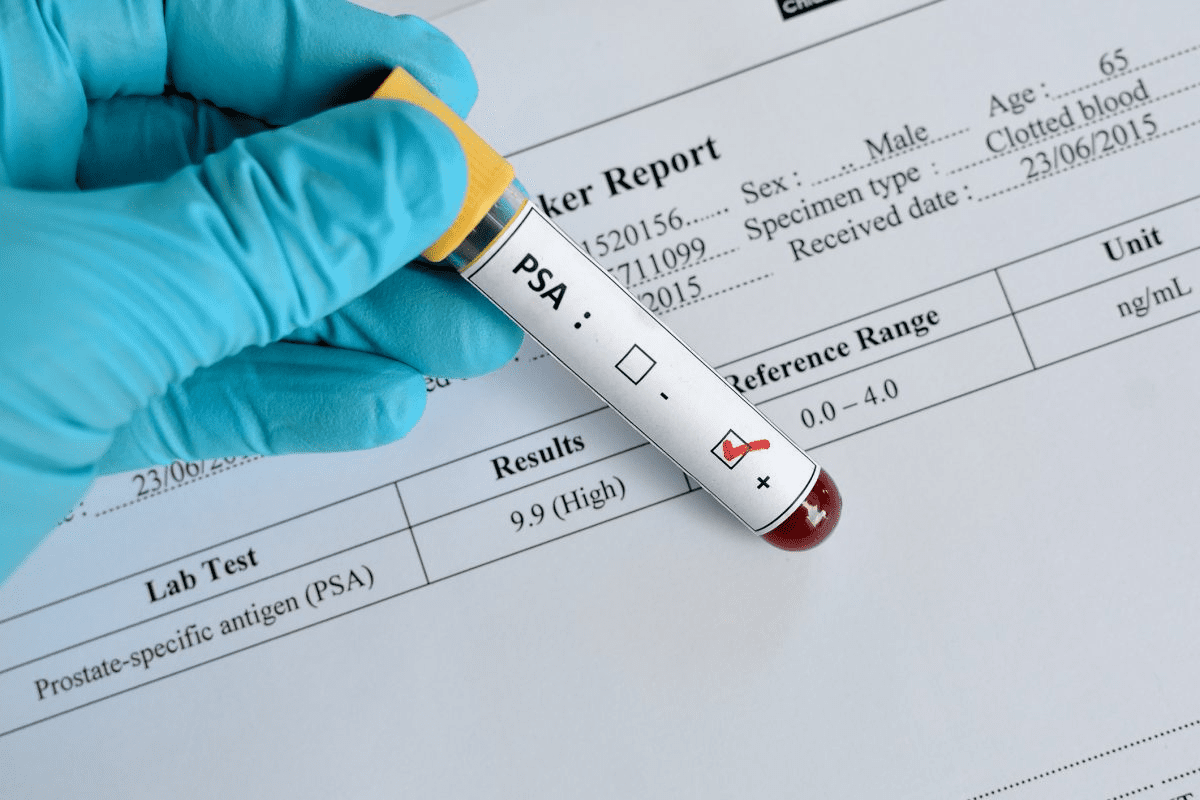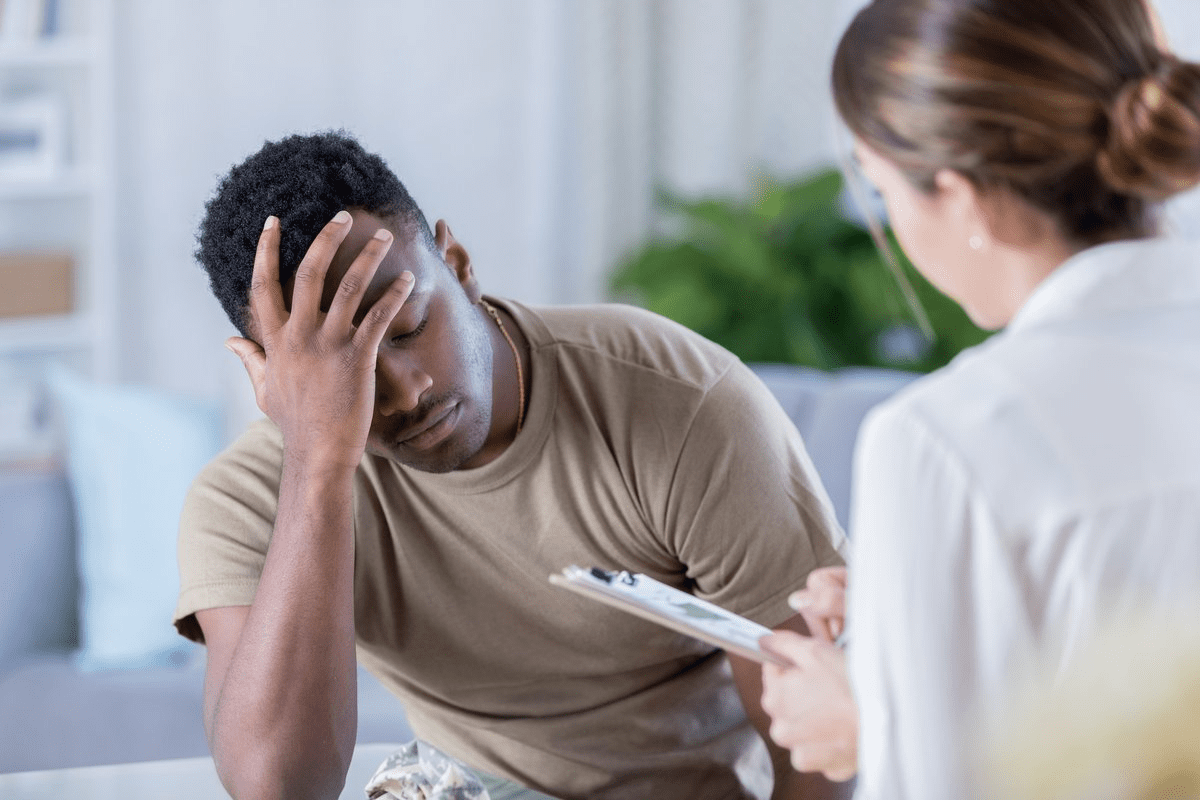Last Updated on November 27, 2025 by Bilal Hasdemir

Scoliosis is a condition where the spine curves abnormally. It affects millions of people worldwide. Many with scoliosis worry about how it changes their body’s look, like their stomach.
It’s common for those with scoliosis to see their stomach sticking out. This can be upsetting.
We’ll look into how scoliosis affects the stomach area. It can change the natural stomach shape and make the stomach bulge out. Knowing how scoliosis and stomach changes are linked is key to dealing with these issues.
Key Takeaways
- Scoliosis can change how the body looks, including the stomach area.
- The condition may cause an abnormal spine curve, affecting the stomach’s natural shape.
- Understanding the connection between scoliosis and stomach changes is vital for managing the condition.
Understanding Scoliosis and Its Impact on Body Posture

Scoliosis is a condition where the spine curves abnormally. It affects not just the spine but also the body’s posture. This can lead to physical changes.
What is Scoliosis?
Scoliosis often shows up in teenagers but can also affect adults. Its cause is often unknown. But it might be linked to genetics or certain conditions.
How Scoliosis Affects Spinal Alignment
The spine curves abnormally in scoliosis. This can upset the balance of the spine. It can also affect other parts of the body, like the abdomen.
Common Symptoms Beyond Curved Spine
Scoliosis can cause more than just a curved spine. It can lead to uneven shoulders and a prominent shoulder blade. It can also change how the hips are aligned.
| Symptom | Description |
| Uneven Shoulders | One shoulder is higher than the other |
| Prominent Shoulder Blade | One shoulder blade sticks out more than the other |
| Uneven Hips | One hip is higher or more prominent than the other |
Knowing about scoliosis is key to managing its effects on posture and health.
The Connection Between Spinal Curvature and Abdominal Appearance

Scoliosis can change how your body looks, making your belly look different. It’s important to understand how your spine affects your belly. This is key for those with scoliosis.
How Spinal Misalignment Shifts Internal Organs
An abnormal spine can move your internal organs. This can make your belly stick out or look odd. How much it changes depends on how severe and where the spine curves.
The Role of Pelvic Tilt in Stomach Protrusion
Pelvic tilt also affects your belly’s look. In scoliosis, the pelvis might tilt because of the spine’s curve. This tilt can make your belly bulge out. It changes how your belly’s contents are spread out.
Muscle Imbalances Contributing to Abdominal Changes
Muscle imbalances are common in scoliosis. They can also change how your belly looks. Weak or tight muscles can cause bad posture and make your belly stick out. Exercises to strengthen your core can help.
Important things to think about include:
- The degree of spinal curvature and its impact on internal organs
- The role of pelvic tilt in altering abdominal appearance
- The effect of muscle imbalances on posture and abdominal protrusion
Understanding and addressing these factors can help manage belly changes in scoliosis.
Does Stomach Naturally Curve Out? Understanding Normal Abdominal Anatomy
It’s important for people with scoliosis to know the natural shape of their abdomen. This helps them tell normal shapes from scoliosis changes. The human abdomen is not flat; it has natural curves that differ from person to person.
Natural Abdominal Contours in Healthy Spines
In healthy spines, the abdomen can look different. This is because of muscle tone, fat distribution, and genetics. Some curves or bulges are normal, like in those with loose abdominal muscles or a softer stomach.
Differentiating Between Normal Curves and Scoliosis-Related Protrusion
It’s key to tell normal curves from scoliosis-caused bulges. Scoliosis changes come from spinal misalignment and muscle imbalances. Doctors can help figure out if a bulge is from scoliosis or something else.
Genetic Factors in Natural Stomach Shape
Genetics greatly affect the natural shape of the abdomen. Some people naturally have a more noticeable stomach, not because of scoliosis. Knowing these genetic factors helps people understand their body better.
| Factors Influencing Abdominal Contours | Description |
| Muscle Tone | Stronger abdominal muscles can lead to a flatter abdomen |
| Body Fat Distribution | Fat accumulation around the abdomen can cause protrusion |
| Genetic Predispositions | Genetic factors can influence natural abdominal shape |
Types of Scoliosis That Most Commonly Affect Abdominal Appearance
It’s important to know about the different types of scoliosis to understand how they affect the belly. Scoliosis is a condition where the spine curves abnormally. Each type of scoliosis has its own way of changing how we look and stand.
Thoracolumbar Scoliosis and Its Effects
Thoracolumbar scoliosis happens in the area where the thoracic and lumbar spine meet. This type can make the belly look uneven. People with thoracolumbar scoliosis might notice their lower belly looks different.
Lumbar Scoliosis and Stomach Protrusion
Lumbar scoliosis mainly affects the lower back. It can make the belly look different, like it’s sticking out or not even. This happens because of how the spine and muscles are out of balance.
Thoracic Scoliosis and Upper Abdominal Changes
Thoracic scoliosis affects the upper and middle spine. It mostly affects the upper body. But, in severe cases, it can also change the upper belly. This is because of how the ribs and diaphragm are shaped differently.
Congenital vs. Idiopathic Scoliosis Effects
Congenital scoliosis is present at birth due to spinal issues. Idiopathic scoliosis has no known cause. Both can change how the belly looks, but in different ways. Congenital scoliosis might cause more noticeable spinal and belly changes.
Key Considerations:
- The type and severity of scoliosis greatly affect the belly.
- Thoracolumbar and lumbar scoliosis often cause noticeable belly changes.
- Knowing the specific type of scoliosis is key to managing its effects.
Why Does My Stomach Stick Out at the Bottom? The Lower Abdomen Connection
People with scoliosis often see their lower belly sticking out. This is not just about looks. It’s tied to the spinal curve of scoliosis.
Anterior Pelvic Tilt and Lower Belly Protrusion
The anterior pelvic tilt plays a big role in this. When the pelvis tilts forward, it pushes the belly out. This tilt happens because of the spinal curve.
Lumbar Lordosis and Its Impact on Lower Abdominal Appearance
Lumbar lordosis affects the lower back’s curve. This can make the belly look like it’s sticking out more. It changes how the belly looks.
Core Muscle Weakness in Scoliosis Patients
Core muscle weakness is common in scoliosis. Weak abs can’t hold the belly in, making it look like it’s sticking out.
Knowing about these factors helps us understand why scoliosis affects the belly. We can then work on managing these changes better.
Upper Stomach Sticking Out: Causes Related to Thoracic Scoliosis
Thoracic scoliosis can make the upper stomach stick out more. This happens when the spine in the thoracic area curves abnormally. It can affect the rib cage, diaphragm, and internal organs.
Rib Cage Deformities and Upper Abdominal Protrusion
The rib cage is key in supporting the upper stomach. In thoracic scoliosis, the spine’s curve can cause rib cage deformities. This makes the upper stomach bulge out.
Diaphragm Position Changes in Thoracic Scoliosis
The diaphragm, a dome-shaped muscle, can be affected by thoracic scoliosis. As the spine curves, the diaphragm’s position changes. This can lead to breathing changes and a different look in the upper stomach.
Organ Displacement in Severe Thoracic Curves
In severe thoracic scoliosis, the spine’s curve can be so big it moves organs. This can push the upper stomach out.
| Cause | Effect on Upper Stomach |
| Rib Cage Deformities | Visible bulge in upper abdominal region |
| Diaphragm Position Changes | Changes in breathing patterns and upper abdominal appearance |
| Organ Displacement | Protrusion of upper stomach area |
How Scoliosis Severity Correlates with Stomach Protrusion
The severity of scoliosis can greatly affect how much the stomach sticks out. This can change how people look and feel. As the spine curves more, it can alter the belly area in different ways.
Abdominal Changes in Mild Scoliosis
In mild scoliosis, where the spine curves 10-25 degrees, the belly doesn’t change much. But, some people might notice small changes in how their belly looks. This is because the spine’s alignment shifts a bit.
Effects of Moderate Scoliosis on Stomach Appearance
When scoliosis is moderate, with a curve of 25-40 degrees, belly changes become more obvious. The spine’s misalignment pushes organs more, making the belly stick out more.
Significant Abdominal Distortion in Severe Scoliosis
Severe scoliosis, with a curve of 40 degrees or more, causes big changes in how the belly looks. The spine’s curve moves organs a lot, making the belly stick out even more.
Progressive Changes Over Time
Scoliosis gets worse over time, and belly changes can too. It’s important to keep an eye on it and get help to lessen these changes.
| Scoliosis Severity | Degree of Curvature | Impact on Stomach Protrusion |
| Mild | 10-25 degrees | Minimal impact |
| Moderate | 25-40 degrees | Noticeable changes |
| Severe | 40+ degrees | Significant distortion |
Digestive Issues Associated with Scoliosis
Scoliosis and digestive health are closely linked. Scoliosis, a condition where the spine curves abnormally, can affect digestion. This is because the spine’s shape can press on organs in the belly.
Can Scoliosis Cause Bowel Problems?
Yes, scoliosis might cause bowel problems. The spine’s curve can push organs in the belly out of place. This can mess with how you go to the bathroom and how you feel in your belly.
Can Scoliosis Cause Digestive Issues?
Yes, scoliosis can lead to digestive problems. The spine’s curve can put pressure on your stomach and intestines. This can cause pain, bloating, and changes in how often you go to the bathroom.
Stomach Pain and Discomfort Related to Spinal Curvature
Stomach pain in scoliosis patients comes from several sources. The spine’s curve, any tilt in the pelvis, and muscle imbalances play a role. These can affect how your belly organs work.
Managing Gastrointestinal Symptoms in Scoliosis Patients
Dealing with stomach issues in scoliosis patients needs a full plan. This might include changing what you eat, doing exercises to strengthen your core, and improving your posture. Sometimes, doctors might need to step in to help with specific symptoms.
Living with scoliosis means more than just fixing the spine. It’s also about taking care of your overall health, including your belly. By understanding how scoliosis affects your gut, you and your doctor can find ways to manage it better.
Differentiating Between Scoliosis-Related Protrusion and Other Causes
It’s important to tell scoliosis-related stomach protrusion apart from other causes. Scoliosis can change how your stomach looks, but other things might also play a part.
Bloating vs. Structural Protrusion
Bloating can make your stomach look bigger, but it’s not the same as scoliosis. Bloating is usually due to digestion problems and can change during the day.
Weight Gain vs. Scoliosis-Related Stomach Changes
Weight gain can make your stomach stick out too. But, in people with scoliosis, the spine’s curve can make the stomach look different in a lasting way.
Diastasis Recti and Other Abdominal Wall Issues
Diastasis recti, where your abdominal muscles split, can also make your stomach bulge. This can happen with scoliosis and needs its own treatment plan.
Hormonal Influences on Abdominal Appearance
Hormonal changes can shape your body and affect how your stomach looks. Knowing this helps doctors fully understand stomach protrusion in scoliosis patients.
Healthcare providers can create better treatment plans by looking at all these factors. This way, they can tackle the real reasons for stomach protrusion in scoliosis patients.
The Psychological Impact of Body Changes from Scoliosis
Scoliosis can greatly affect a person’s body image, causing various psychological effects. As the condition worsens, noticeable changes in body shape and posture occur. These changes can alter how individuals see themselves.
Body Image Concerns Related to Stomach Protrusion
The stomach protrusion from scoliosis can cause appearance-related anxiety. People may feel embarrassed about their looks. They might avoid certain clothes or social events.
Coping Strategies for Appearance-Related Anxiety
We suggest several coping strategies for managing appearance-related anxiety. These include:
- Seeking support from family and friends
- Engaging in activities that promote self-esteem
- Consulting with mental health professionals
Building Confidence Despite Physical Changes
Building confidence is key for those facing scoliosis’s physical changes. Focus on your abilities and strengths, not just your looks.
| Coping Strategies | Benefits |
| Seeking Support | Reduces feelings of isolation |
| Promoting Self-Esteem | Enhances overall confidence |
| Mental Health Support | Provides professional guidance |
By using these strategies, people with scoliosis can handle the condition’s psychological effects better. This can improve their overall well-being.
Non-Surgical Approaches to Address Stomach Protrusion in Scoliosis
For those with scoliosis, there are many ways to tackle stomach protrusion without surgery. We’ll look at different non-surgical methods that can help.
Physical Therapy Exercises for Core Strengthening
Physical therapy is key in managing scoliosis-related belly changes. Exercises that strengthen the core can improve posture and lessen stomach protrusion. Targeted exercises help balance and stabilize muscles, which can make the belly look less protruded.
Posture Correction Techniques
Improving posture is essential in managing scoliosis. By straightening the spine, people can lessen the belly’s appearance. Techniques like conscious posture correction and postural awareness exercises are very helpful.
Bracing Options and Their Effects on Abdominal Appearance
Bracing is a common non-surgical method for scoliosis. Some braces can correct spinal curves, which might reduce stomach protrusion. The success of bracing depends on the scoliosis’s severity and the brace type.
Schroth Method and Other Specialized Scoliosis Therapies
The Schroth Method is a physical therapy for scoliosis. It focuses on exercises to correct spinal deformities and improve posture. Along with other specialized therapies, it can manage scoliosis-related belly changes effectively.
| Therapy | Focus | Benefits |
| Physical Therapy | Core strengthening, posture improvement | Reduces stomach protrusion, improves muscle balance |
| Posture Correction | Spinal alignment, postural awareness | Enhances posture, reduces scoliosis impact on abdomen |
| Bracing | Spinal curvature correction | Reduces stomach protrusion, corrects spinal deformity |
| Schroth Method | Exercises for spinal deformity correction | Improves posture, reduces scoliosis-related changes |
By using these non-surgical methods together, people with scoliosis can reduce stomach protrusion and improve their life quality.
Surgical Interventions for Severe Scoliosis and Their Impact on Abdominal Appearance
For those with severe scoliosis, surgery can offer big relief. It can also improve how the spine looks and feels. Surgery is considered when the curve of the spine is very big and affects daily life.
Spinal Fusion Surgery and Postoperative Changes
Spinal fusion surgery is a common choice for severe scoliosis. It joins vertebrae to make the spine stable. After surgery, the spine might look better, which could make the belly look different too.
Vertebral Body Tethering and Minimally Invasive Approaches
Vertebral body tethering is a new, less invasive surgery. It corrects the spine but keeps it flexible. This method might have less effect on the belly compared to older surgeries.
Recovery Timeline for Abdominal Appearance Improvement
How long it takes to see belly changes varies. But, as the spine gets stronger and posture improves, belly changes are noticeable. Most see big changes in the first year after surgery.
Realistic Expectations for Post-Surgical Body Changes
It’s key for patients to know what to expect. Surgery can make the spine and belly look better. But, how much it changes depends on the scoliosis’s severity and overall health.
Clothing and Fashion Tips for Those with Scoliosis-Related Stomach Protrusion
For those with scoliosis, the right clothes can change everything. They can boost your confidence and make you feel more comfortable.
Flattering Clothing Styles and Cuts
It’s important to choose flattering clothing. Look for styles that hide the midsection, like A-line dresses and skirts. Tops with unique necklines are also good choices. Dark colors on the bottom can make you look slimmer.
Supportive Garments and Compression Options
Supportive garments and compression options offer extra comfort. Try wearing compression tops or shapewear for support during the day or when exercising.
Customization and Tailoring Recommendations
Customizing your clothes can really help. Think about tailoring your clothes to fit you perfectly. Or look for brands with customizable clothing options for a better fit.
Nutritional Considerations for Scoliosis Patients with Abdominal Discomfort
Diet can really help those with scoliosis who have tummy troubles. It’s key to know how certain foods can ease scoliosis symptoms.
Anti-Inflammatory Diet Approaches
An anti-inflammatory diet is good for scoliosis patients with tummy pain. It includes foods high in omega-3s, antioxidants, and fiber. These help lower inflammation and improve digestion. Good choices are fatty fish, leafy greens, and whole grains.
Managing Bloating and Digestive Discomfort
It’s important to manage bloating and tummy pain for scoliosis patients. Stay away from gas-causing foods like beans and broccoli. Eat smaller meals more often. Also, adding probiotics and prebiotics can help your gut and cut down on bloating.
Hydration and Its Impact on Abdominal Comfort
Drinking enough water is key for a comfy tummy. It helps avoid constipation, cuts down on bloating, and keeps digestion healthy. Drink at least eight glasses a day, but adjust based on how active you are and your body’s needs.
Supplements That May Help with Scoliosis-Related Symptoms
Some supplements can help scoliosis patients with tummy issues. Omega-3s, probiotics, and vitamin D can fight inflammation and boost digestion. But, always talk to a doctor before taking any supplements.
| Nutritional Approach | Benefits for Scoliosis Patients |
| Anti-Inflammatory Diet | Reduces inflammation, promotes digestive health |
| Bloating Management | Alleviates discomfort, reduces gas |
| Proper Hydration | Prevents constipation, reduces bloating |
| Supplements | Supports overall health, reduces inflammation |
Exercise Recommendations to Improve Core Strength and Abdominal Appearance
Exercise is key in managing scoliosis. It helps strengthen the core and improve how the abdomen looks. A good exercise plan can make the spine stronger and posture better.
Safe Core Strengthening for Scoliosis Patients
Core exercises are a must for scoliosis patients. Safe exercises include:
- Planks: Held for 30-60 seconds to engage core muscles
- Bridges: Strengthens lower back and gluteal muscles
- Pelvic tilts: Helps in stabilizing the lower back
Exercises to Avoid with Scoliosis
But, some exercises can make scoliosis worse. Exercises to avoid include:
- High-impact activities like jumping or heavy lifting
- Contact sports that may cause spinal injury
- Exercises that involve heavy twisting or bending
Yoga and Pilates Modifications for Scoliosis
Yoga and Pilates can help when modified for scoliosis. Modifications include:
- Avoiding deep twists and bends
- Focusing on gentle stretches and core strengthening
- Using props to support the spine during exercises
Swimming and Water Therapy Benefits
Swimming is great for scoliosis patients. It’s a low-impact, full-body workout. Benefits include:
- Improved cardiovascular health
- Strengthening of muscles without putting excessive strain on the spine
- Enhanced flexibility and range of motion
When to Seek Medical Attention for Stomach Protrusion with Scoliosis
Knowing when to get medical help for scoliosis-related stomach issues is key. Scoliosis can cause big changes in the abdomen that need quick medical care.
Warning Signs of Complications
Some symptoms show scoliosis and stomach protrusion complications. These include:
- Severe abdominal pain
- Difficulty breathing
- Significant changes in bowel habits
- Unexplained weight loss
If you notice these signs, get medical help right away. As “Early intervention can significantly improve outcomes for scoliosis patients.”
Finding Specialists in Scoliosis Management
Finding the right healthcare provider is key for scoliosis management. Look for specialists with scoliosis experience. You can start by:
- Asking your primary care physician for recommendations
- Checking with professional medical organizations for certified specialists
- Reading patient reviews and testimonials
“A specialist with a focus on scoliosis can provide tailored advice and treatment options.”
Questions to Ask Your Healthcare Provider
When talking to your healthcare provider, come ready with questions. Important ones include:
- What are the possible causes of my stomach protrusion?
- Are there non-surgical treatments available?
- What are the risks and benefits of surgery?
Being informed and proactive helps you work well with your healthcare provider. Together, you can manage your scoliosis and abdominal changes effectively.
Conclusion: Living Confidently with Scoliosis-Related Body Changes
Scoliosis can really affect how we stand and feel about ourselves. We’ve looked into how it changes our posture and belly look. Knowing how spinal curves and stomach bulges are linked helps us handle scoliosis better.
To feel good with scoliosis, we need a full plan. This includes treatments that don’t involve surgery, changing our lifestyle, and getting emotional support. By working on our core, improving our posture, and choosing the right treatment, we can lessen scoliosis’s impact.
It’s important to accept and deal with body changes and focus on feeling well overall. We suggest getting help from experts, looking into treatments, and finding others who understand what we’re going through. This way, people with scoliosis can live fully and confidently, even with the challenges it brings.
FAQ
Does scoliosis cause stomach protrusion?
Scoliosis can lead to stomach protrusion due to spinal misalignment and muscle imbalances. The extent of protrusion depends on the scoliosis’s severity and type.
Why does my lower stomach stick out with scoliosis?
Lower stomach protrusion in scoliosis is often caused by pelvic tilt and muscle weakness. These factors shift the abdominal contents forward, making the lower abdomen more pronounced.
Can scoliosis cause digestive issues?
Yes, scoliosis can lead to digestive problems like bowel issues and stomach pain. The spinal curvature can put pressure on abdominal organs, affecting their function.
How does the severity of scoliosis affect stomach protrusion?
The severity of scoliosis affects stomach protrusion. Mild scoliosis may cause little change, while severe scoliosis can cause significant distortion.
What are the non-surgical approaches to addressing stomach protrusion in scoliosis?
Non-surgical methods include physical therapy for core strengthening and posture correction. Bracing and specialized therapies like the Schroth Method are also options.
Can exercise improve core strength and abdominal appearance in scoliosis?
Yes, exercises can strengthen the core muscles, improving abdominal appearance in scoliosis. Swimming, yoga, and Pilates are good options when modified for scoliosis.
How can I manage bloating and digestive discomfort with scoliosis?
To manage bloating and digestive discomfort, follow an anti-inflammatory diet and stay hydrated. Working with a healthcare provider to address symptoms is also key.
What clothing styles are recommended for individuals with scoliosis-related stomach protrusion?
Flattering clothing and supportive garments can minimize stomach protrusion. Customization and tailoring can also enhance confidence in your fit.
When should I seek medical attention for stomach protrusion with scoliosis?
Seek medical attention for severe pain, breathing difficulties, or significant abdominal changes. Consult specialists in scoliosis management for evaluation and guidance.
Can scoliosis surgery improve abdominal appearance?
Scoliosis surgery, like spinal fusion, can improve abdominal appearance by correcting the spinal curvature. The outcome varies based on the individual’s condition and scoliosis severity.
How can I build confidence despite physical changes from scoliosis?
Building confidence involves coping with appearance anxiety and focusing on health. Find supportive communities, practice self-care, and celebrate achievements to help.
Is it normal for the stomach to curve out naturally?
The natural shape of the abdomen varies due to genetics, body type, and muscle tone. While some curvature is normal, excessive protrusion may indicate underlying conditions like scoliosis.
Can hormonal influences affect abdominal appearance in scoliosis?
Hormonal changes can affect abdominal appearance, potentially worsening bloating. In scoliosis, structural changes due to spinal curvature play a bigger role in stomach protrusion.
References
- Boyapati, N. (2024). Gastric outlet obstruction secondary to severe thoracolumbar scoliosis. Fiona Stanley Hospital, Acute Surgical Unit. https://www.ncbi.nlm.nih.gov/pmc/articles/PMC10771233/






